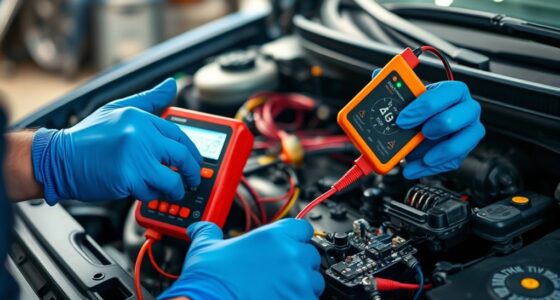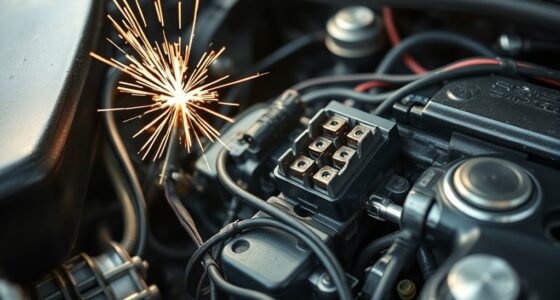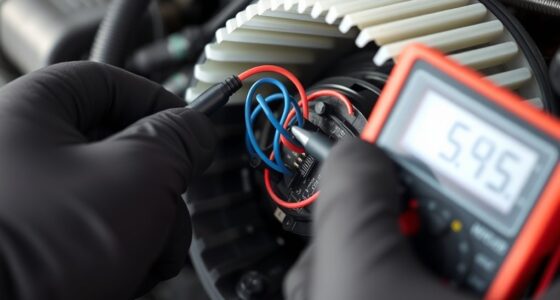If your dashboard shows a battery warning light, your headlights flicker, or accessories like the radio act up, your alternator might be failing. Other signs include dim lights even with a new battery, strange smells, or fluctuating instrument readings. Worn belts, corrosion on terminals, and internal overheating can cause these issues. Understanding these symptoms and causes helps you catch problems early—keep going to learn more about how to diagnose and fix them.
Key Takeaways
- Battery warning light appears on the dashboard, indicating potential alternator issues.
- Dim or flickering headlights suggest insufficient electrical output from the alternator.
- Worn belts or corrosion on terminals impair alternator operation and cause failure symptoms.
- Fluctuating instrument readings and malfunctioning electrical accessories signal internal alternator problems.
- Internal component failure, overheating, or wiring issues are common causes of alternator failure.

Your vehicle’s alternator plays a crucial role in powering the electrical system and charging the battery, but when it begins to fail, you’ll notice clear warning signs. One of the most common early indicators is a battery warning light on your dashboard. This light often appears when the alternator isn’t generating enough power to keep the battery charged, signaling you to check your electrical system promptly. Ignoring this warning can lead to a dead battery and a vehicle that won’t start. Alongside the warning light, you might notice your headlights becoming dim or flickering, especially at idle or when using electrical accessories like the radio or air conditioning. Dim headlights are a direct sign that your alternator isn’t supplying sufficient power, and this can happen even if your battery is relatively new. The alternator’s failure compromises the electrical flow, causing lights and other electronic components to struggle.
Another sign to watch for is rapid or irregular fluctuations in your dashboard’s instrument cluster. This could include erratic readings on your speedometer or tachometer, which often happen when the alternator’s internal components, like the voltage regulator, are malfunctioning. You might also notice a strange smell, such as burning rubber or wiring, which can occur if the alternator’s internal parts overheat or short circuit. Additionally, some vehicles may experience issues with accessories like power windows, heated seats, or the audio system, as these rely on a steady power supply that the failing alternator can’t provide.
If your battery warning light appears and your headlights are dimming, it’s time to get your alternator tested. A simple voltage test with a multimeter can reveal whether your alternator is producing the correct voltage, typically around 13.5 to 14.5 volts when the engine is running. If the reading is below this range, it suggests your alternator isn’t generating enough power. Sometimes, worn-out belts or corrosion on the alternator terminals can also cause these symptoms, so inspecting these components can help identify the root cause.
Frequently Asked Questions
Can an Alternator Fail Gradually or Suddenly?
An alternator can fail gradually or suddenly. If it fails gradually, you might notice battery drain over time, dimming headlights, or electrical noise from your car’s system. Sudden failure often causes your vehicle to stall or lose power quickly, leaving you stranded. Pay attention to warning signs like flickering lights or a warning dashboard light, and get it checked promptly to avoid more extensive damage.
How Long Does a Typical Alternator Last?
Most alternators last between 80,000 to 150,000 miles, roughly 5 to 10 years, depending on your vehicle and driving conditions. You might notice your battery lifespan shortening if the alternator isn’t functioning properly, leading to increased electrical system wear. Regular maintenance can extend its life, but eventually, signs of failure will appear. Keep an eye on dashboard lights and electrical issues to catch problems early.
Are There Specific Driving Conditions That Harm an Alternator?
Certain driving conditions can harm your alternator. Weather impact, like extreme heat or cold, stresses your vehicle’s electrical system, making the alternator work harder or degrade faster. Additionally, carrying a high electrical load from accessories like headlights, heated seats, or a sound system increases strain on the alternator. Prolonged exposure to these conditions accelerates wear, so it’s essential to monitor your vehicle’s electrical system and address issues promptly.
Can a Failing Alternator Damage Other Vehicle Components?
A failing alternator is like a sinking ship, risking damage to your other vehicle components. When it malfunctions, it can cause battery drain and electrical issues, which may lead to your vehicle’s sensitive electronics, like the ECU or sensors, getting damaged. Ignoring these signs might leave you stranded and costly repairs. So, keep an eye on your alternator, or you risk damaging more than just your wallet.
Is It Safe to Drive With a Weak or Failing Alternator?
It’s not safe to drive with a weak or failing alternator because it can cause battery drain and lead to electrical issues that leave you stranded. Your vehicle relies on the alternator to power the electrical system and recharge the battery. When it’s failing, you risk losing power to essential components, which could cause safety hazards. Get your alternator checked and replaced promptly to avoid breakdowns and guarantee safe driving.
Conclusion
Don’t ignore the warning signs of alternator failure, or you might find yourself stranded when you least expect it. Keep an eye on dimming headlights, warning lights, or dead batteries—these are your car’s cry for help. Remember, “A stitch in time saves nine,” so address issues early. Staying proactive keeps your vehicle running smoothly and saves you from bigger headaches down the road. Stay alert, and your car will thank you.









